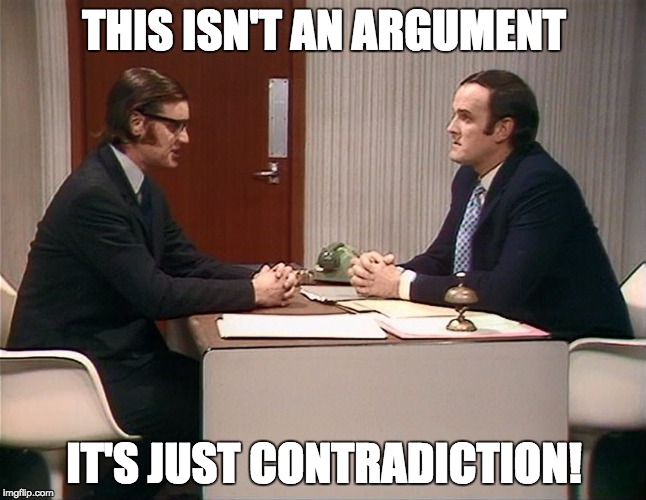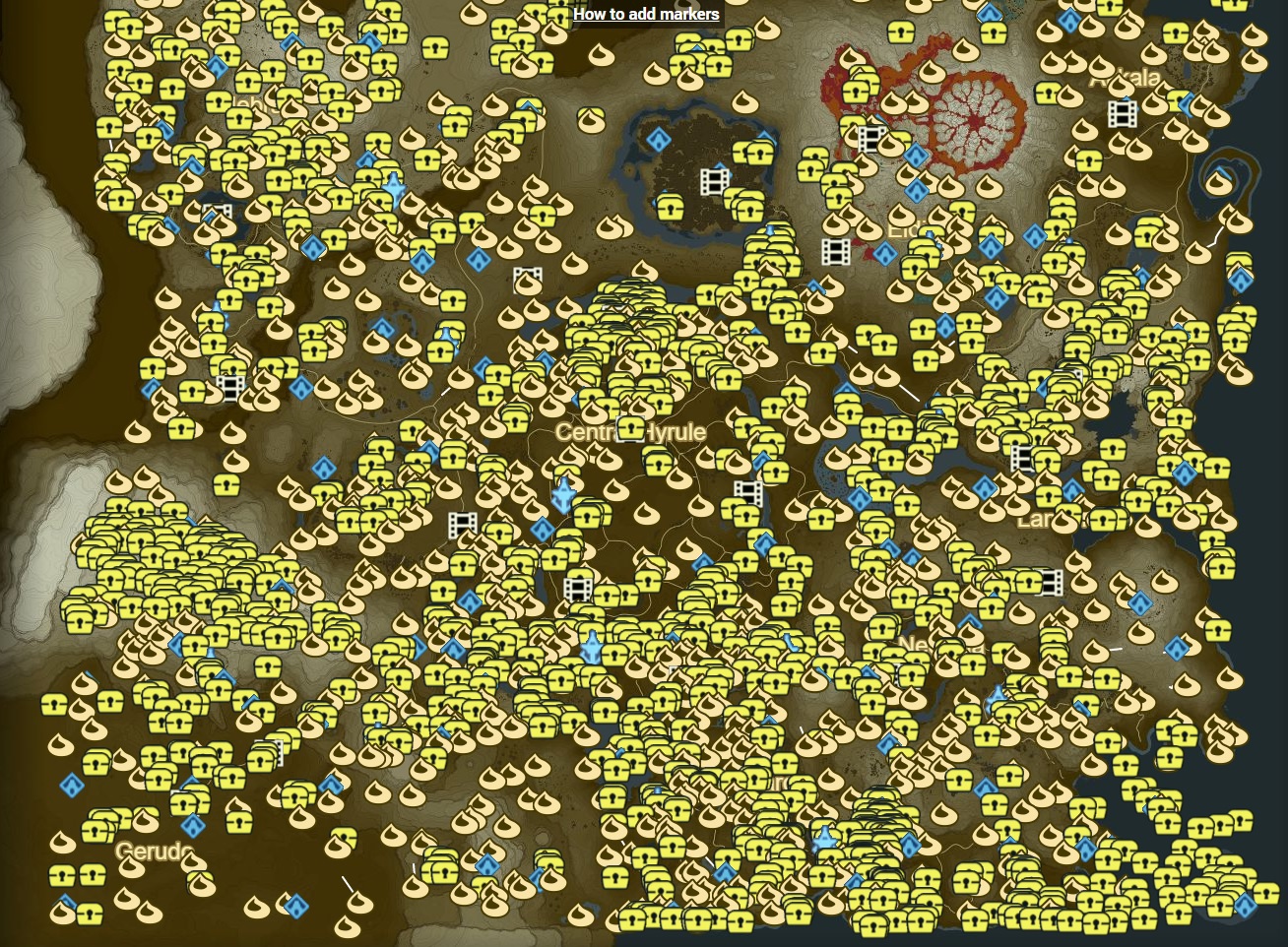BotW was my first Zelda game as well, and it left an incredible first impression during the initial half a dozen hours thanks to its fun physics interactions. But as I played the game to completion, that initial euphoria steadily gave way to disappointment. Comparing BotW to the Gothics, Stalkers and New Vegas (my favorite open world games), there are just too many areas where it falls short:
1. The Open World is Populated with Repetitive Content: Stuff one can do in BotW's world can be broadly broken down into the following categories: 15 Sheikah Towers to climb, 18 Zelda memories to uncover, dozens of copy-pasted enemy camps to clear for a treasure chest, 120 Shrines to complete, and 900 Korok seeds to discover. While BotW does not suffer from Ubisoft's icon vomit as soon as one activates a tower, the underlying structure of the open world content is too similar for my liking; the open world content essentially amounts to a handful of different activities, and each of these activities is repeated dozens if not hundreds of times with minor variations in a bid to pad out the world. To put this into perspective, the 5 kinds of activities I mentioned before would make BotW's map look like so when mapped out:
The map is filled willy-nilly with countless collectibles and activities that one can easily mistake it for a map from a Ubisoft game. Now compare how Gothic 1 populates its map:
In comparison, Gothic 1's world feels far more organic, with each point of interest containing a unique place, dungeon or npc with actual relevance to the world, and none of Gothic's points of interests fall into BotW's checklist way of designing open world content. In this case, less is definitely more (memorable).
2. The Actual Exploration has no Sense of Danger: BotW has the right ideas but bungles the execution when it comes to providing obstacles that the player must overcome while exploring. For instance, certain Sheikah towers initially seem too high to be climbable with the default stamina, but the game's design defeats the entire stamina mechanic by allowing the player to consume as many stamina replenishing consumables as needed while pausing the game, essentially turning what might have been a tense tower climb into just another flavor of Assassin's Creed towers. Similarly, when the game introduced fire-filled and ice-covered areas, I thought it could be a glorious return to STALKER-esque design where the player is scrambling just to survive deadly environmental hazards. Instead, right next to the hot and cold areas are conveniently placed villages that sell full sets of heat and cold immunity gear, respectively.
Thus, the onus then falls on the enemy AI to provide the sole source of challenge, and it is comically ill-equipped to do so. The enemy AI has no answer to the player gliding away or even running straight through their encampments. Even though there are enemies that can one shot the player's base hp early in the game, the game world is abundant with consumables that raise the maximum hp so this stops being an issue early on. The only challenge to BotW's exploration is to have the patience required to trek and glide through a far too huge map to reach the shrine/tower at the other end of the screen.
3. Durability System Guts Exploration Rewards: Thanks to weapons breaking after 2 minutes of combat, the game constantly showers the player with weapons they have already seen before. One of the most deflating experiences in the game was opening a chest in a shrine that contained a duplicate of the fire sword that I thought was unique and was overjoyed to find a couple of hours back -- it was then that I realized that the durability system made almost all weapons into nothing more than a consumable item one finds repeatedly and multiple copies of, sapping all my excitement for any future weapon finds. In the second half of the game I'd constantly throw chest contents right into the abyss because of the frequency with which the game kept throwing duplicates at me coupled with a lack of inventory space.
Another unfortunate aspect of the durability system is that the game needs a replenishing source of weapons for the player since chests do not respawn. BotW's solution in the form of Blood Moons respawning all enemies across the world robs the world of a feeling of persistence. Compared to the Gothics, Stalkers and New Vegas where even quest-related NPCs can die, the Blood Moon prevents even enemies from permanently dying, making BotW's incredibly interactive world seem paradoxically static at the same time.
4. Environmental Traversal and Shrine Puzzles Never Escalate in Challenge: I played my first metroidvania in Hollow Knight right before BotW, and that colored my expectations for rising environmental traversal challenges as a game progresses. BotW never has inaccessible areas that a player should revisit later to unlock. This oversight is a giant missed opportunity in world design, especially since each of the 4 divine beasts unlocks a new ability for the player. If BotW had areas that could only be accessed by using a specific divine beast skill, it would have gone a long way towards making environmental traversal not feel such a flat unchanging experience.
Even though Shrine puzzles were uniformly too short, easy and mostly unremarkable except for a few standout puzzles, they were still my favorite part of the whole game, pushing me to complete all 120 of them. My biggest disappointment with the puzzle design in this game is that I cannot recall a single divine beast or Shrine that required the use of all 4 of the runes to progress. Most of the puzzles can be completed with just the use of 1 or 2 runes, with outliers requiring 3. I expected the divine beasts and Shrines that can only be accessed after defeating specific divine beasts to contain challenging puzzles that required full use of all the runes, but the game never met these expectations.
5. Combat is Best Avoided Entirely: Unless one is grinding for materials to improve armor, there is no point to engaging in combat out in the open world. The combat mechanics and enemy variety leave a lot to be desired and struggle to sustain a combat heavy playstyle over the dozens of hours the game can last. Melee combat lacks depth and devolves into circle strafing trash mobs awkwardly (the target lock while strafing is absolutely bizarre in BotW, with the camera not being locked behind Link's back -- a standard practice in a game involving melee combat and target locking) or baiting tough enemies into parries and flurries. Even when the player is in danger of dying, a return to full hp is only a game pause and consumable away. Enemy variety is shocking, with the vast majority of the game featuring the same 3 enemy types, albeit with recolored versions boasting hp bloat and the same moveset.
The only positive thing I found about the combat is the arrow drop mechanic while using bows. The immense satisfaction on nailing a headshot on an enemy half a screen away never got old.
6. The Side Quests Would Make MMOs Blush: Without mincing any words, BotW has the worst side quest content of the games I've played in recent years. I generally like to complete as many side quests as possible before progressing the main quest, but in order to not drop the game entirely, I had to abandon the side quests in BotW. They were all fetch quests, and as the game wore on, the quantity of fetching required increased exponentially. At the start of the game, most quests required a single item or two to complete, but that soon ballooned to 5, 10, 20, 55 and all the way to 110 for the Tarrey Town quest. Given the vendor trash rewards for these quests, the quest writing would have to be exceptional to justify that amount of fetching, but the quest writing in BotW is anything but exceptional, with threadbare characters, generic motivations, and banal quest setups.
Summing up BotW, I found it to be a game of wonderful physics interactions stuck in a map that was too large for its own good, leading to a repetitive structure and puzzle content that was stretched too thin to accommodate the size of the world. The game also never combined the open world and puzzles in a satisfying manner; the gameplay inside Shrines has a different playstyle compared to the gameplay that occurs out in the open world, making the game feel as if it has two distinct halves -- one that occurs inside Shrines and one that occurs outside. I found the Shrines' puzzle gameplay to be more enduring than the open world gameplay, despite initially being drawn to the title on hearing about its open world design. So, even though BotW disappointed me as an open world game, it has also served as a gateway game and made me curious about checking out older Zelda games, hopefully ones with a stronger puzzle focus.


















